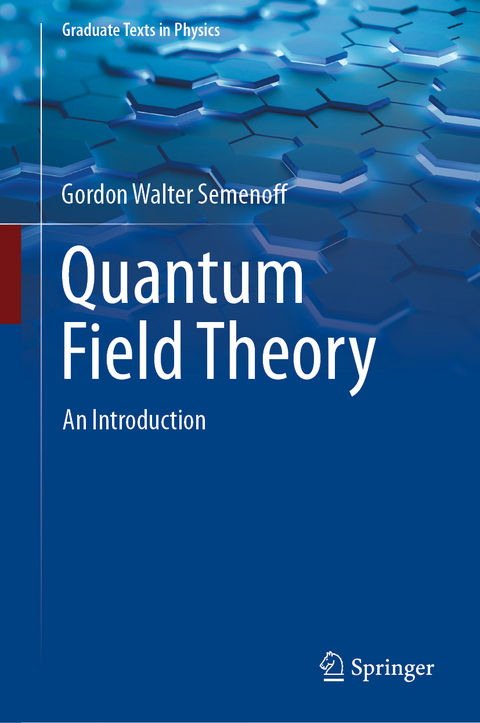
Quantum Field Theory
Springer Verlag, Singapore
9789819954094 (ISBN)
- Titel nicht im Sortiment
- Artikel merken
Gordon W. Semenoff is Professor at The University of British Columbia in Vancouver, Canada. His research examines the nature at its most fundamental level. His recent interests have been in superstring theory and duality of string theories with strongly coupled gauge field theories and in quantum gravity. He is also interested in quantum information theoretic questions in quantum field theory.
lt;p>1Many Particle Physics as a Quantum Field Theory
1.1 Introduction
1.2 Non-relativistic particles
1.2.1 Identical particles
1.2.2 Spin
1.3 Second Quantization
1.4 The Heisenberg picture
2 Degenerate Fermi and Bose Gases
2.1The limits of large volume and weakly interacting particles
2.2Degenerate Fermi gas and the Fermi surface
2.2.1 The ground state |O >
2.2.2 Particle and holes
2.2.3 The grand canonical ensemble
2.3 Bosons
3 Classical field theory and the action principle
3.1The Action Principle
3.1.1 The Action
3.1.2 The action principle and the Euler-Lagrange equations
3.1.3 Canonical momenta, Poisson brackets and Commutation relations
3.2Noether's theorem
3.2.1 Conservation laws and continuity equations
3.2.2 Definition of symmetry3.2.3 Examples of symmetries
3.2.4 Proof of Noether's Theorem
3.3Phase symmetry and the conservation of particle number
4 Non-relativistic space-time symmetries
4.1Translation invariance and the stress tensor
4.2Galilean symmetry
4.3Scale invariance
4.3.1 Improving the stress tensor
4.3.2 The consequences of scale invariance
4.4Special Schrödinger symmetry
5 Space-time symmetry and relativistic field theory
5.1Quantum mechanics and special relativity
5.2Coordinates
5.3Scalars, vectors, tensors
5.4The metric
5.5Symmetry of space-time
5.6The symmetries of Minkowski space
6 Emergent relativistic symmetry
6.1Phonons
6.2The free scalar field theory
6.3The Debye theory of solids
6.4Relativistic Fermions in Graphene
7The Dirac Equation
7.1The Dirac equation
7.2Natural units
7.3Solving the Dirac equation7.4Lorentz Invariance of the Dirac equation
7.5Spin of the Dirac field
7.6 Phase symmetry and the conservation of particle number
current7.6.1 Conserved number current
7.6.2 Relativistic Noether's Theorem for the Dirac equation
7.6.3 Alternative Proof of Noether's Theorem
7.7 Spacetime symmetries of the Dirac theory
7.7.1 Translation Invariance and the Stress Tensor
7.7.2 Lorentz Transformations
7.7.3 Stress Tensor and Killing Vectors
8 Photons
8.1 Relativistic Classical Electrodynamics
8.1.1 The Photon Hamiltonian8.1.2 Massive photon (Optional reading)
8.2 Space-time symmetries of the photon
8.3 Quantum Electrodynamics
9 Functional methods
9.1 Functional derivative
9.2 Functional integral
9.3 Real Scalar Field
9.3.1 Generating functional for free scalar fields
9.3.2 Wick's theorem for scalar fields9.3.3 Generating functional as a functional integral
9.4 The self-interacting real scalar field
9.5 Analyticity
10 More Functional Integrals
10.1 Functional Integrals for the Photon Field
10.2 Functional Methods for Fermions
10.3 Generating functionals for non-relativistic Fermions
10.3.1 Interacting non-relativistic Fermions
10.4 The Dirac field
10.4.1 2-point function for the Dirac field
10.4.2 Generating functional for the Dirac Field10.4.3 Functional integral for the Dirac field
10.5 Functional Quantum Electrodynamics
11 The Weakly Coupled Scalar Field Theory
11.1 The S-Matrix11.2 Counterterms
11.3 Computation of the 2-point function
11.4 Feynman diagrams
11.5 Simplifications of Feynman diagrams
11.6 The 4-point function
11.7 Computation of a one-loop Feynman Integral
11.7.1 Dimensional regularization
11.7.2 Wick Rotation
11.7.3 Feynman Parameters
11.7.4 Integration in 2w-dimensions
11.7.5 Asymptotic expansion at 2w - 4
11.7.6 Inverse Wick rotation
11.7.7 The mass tadpole
11.7.8 The 2- and 4-point functions
11.8 Subtraction Schemes
11.9 Elastic scattering amplitude
11.10 Connected Correlations and Goldstone's Theorem
11.10.1 Connected Correlation Functions
11.10.2 Goldstone's Theorem
11.10.3 Irreducible Correlation functions
11.11Integration formulae
11.11.1 Feynman Parameter Formula
11.11.2 Dimensional regularization integral
11.11.3 Euler's Gamma function
12 Perturbative Quantum Electrodynamics
12.1 Counterterms
12.2 The generating functional in perturbation theory
12.2.1 Wick's Theorem for Photons and Fermions
12.3 Feynman diagrams
12.3.1 Feynman rules
12.3.2 Fermion 2-point function
12.4 The photon 2-point function
12.5 Quantum corrections of the Coulomb potential
13 Generating Functionals and Quantum Electrodynamics
13.1 Connected Correlations and Goldstone's theorem
13.1.1 Connected Correlation Functions
13.1.2 Goldstone's Theorem
13.2 Furry's theorem
13.3 The Ward-Takahashi identities
13.4 Irreducible Correlation Functions| Erscheinungsdatum | 15.11.2023 |
|---|---|
| Reihe/Serie | Graduate Texts in Physics |
| Zusatzinfo | 5 Illustrations, color; 35 Illustrations, black and white |
| Verlagsort | Singapore |
| Sprache | englisch |
| Maße | 155 x 235 mm |
| Themenwelt | Naturwissenschaften ► Physik / Astronomie ► Atom- / Kern- / Molekularphysik |
| Naturwissenschaften ► Physik / Astronomie ► Hochenergiephysik / Teilchenphysik | |
| Naturwissenschaften ► Physik / Astronomie ► Quantenphysik | |
| Naturwissenschaften ► Physik / Astronomie ► Theoretische Physik | |
| Schlagworte | Dirac Field • Elastic scattering • Fermi and Bose gases • Feynman diagrams • Goldstone's Theorem • Goldstone’s Theorem • many particle physics • Non-relativistic space-time • Photon Hamiltonian • quantum electrodynamics • Relativistic symmetry • Renormalization Group • Second Quantization |
| ISBN-13 | 9789819954094 / 9789819954094 |
| Zustand | Neuware |
| Informationen gemäß Produktsicherheitsverordnung (GPSR) | |
| Haben Sie eine Frage zum Produkt? |
aus dem Bereich


